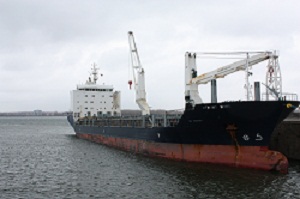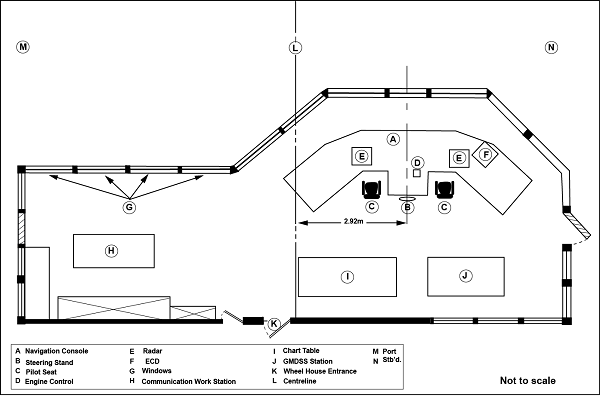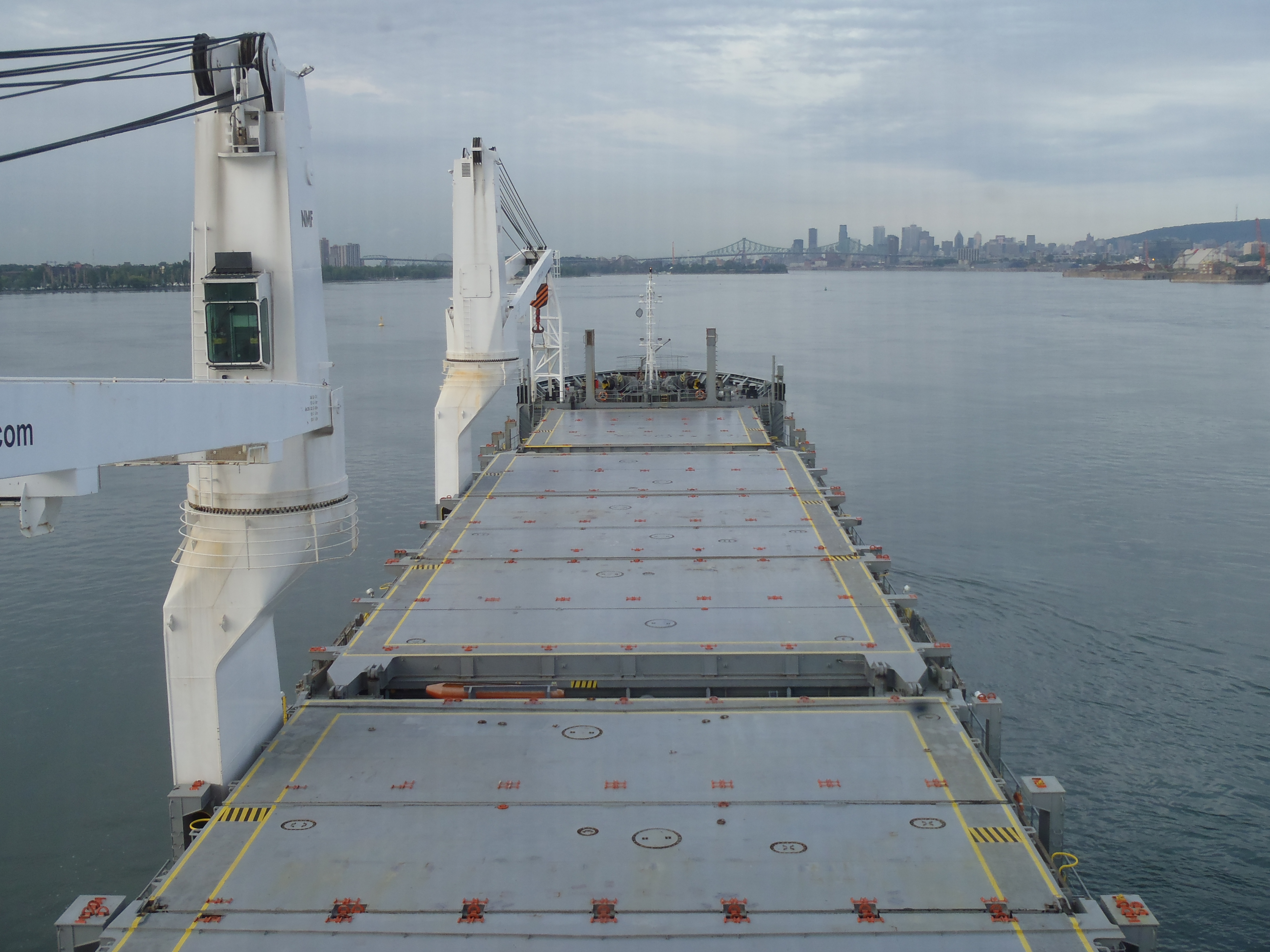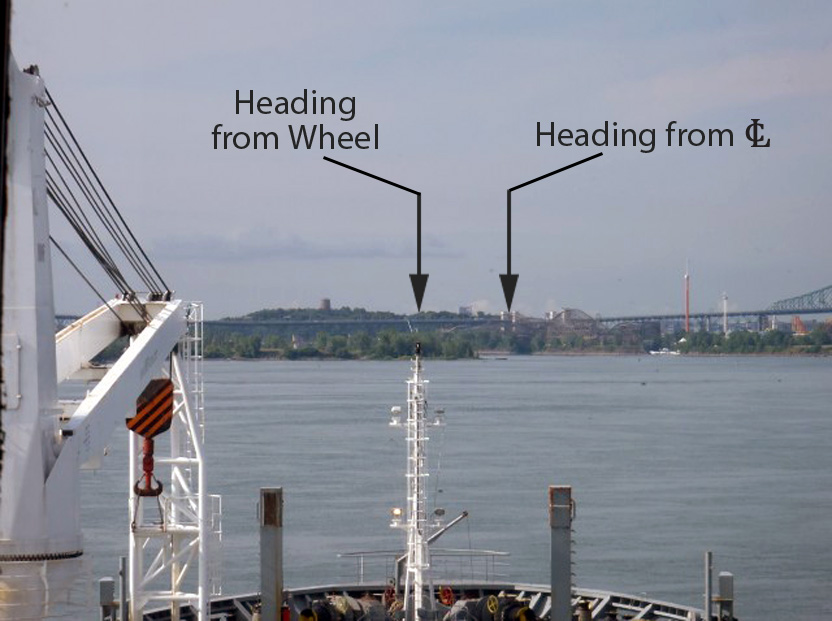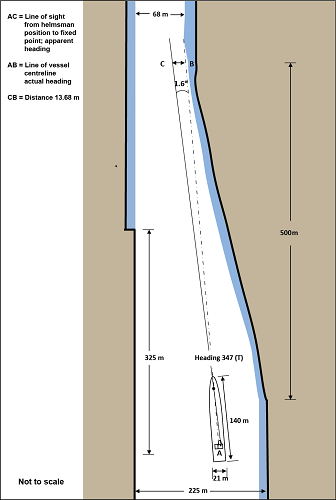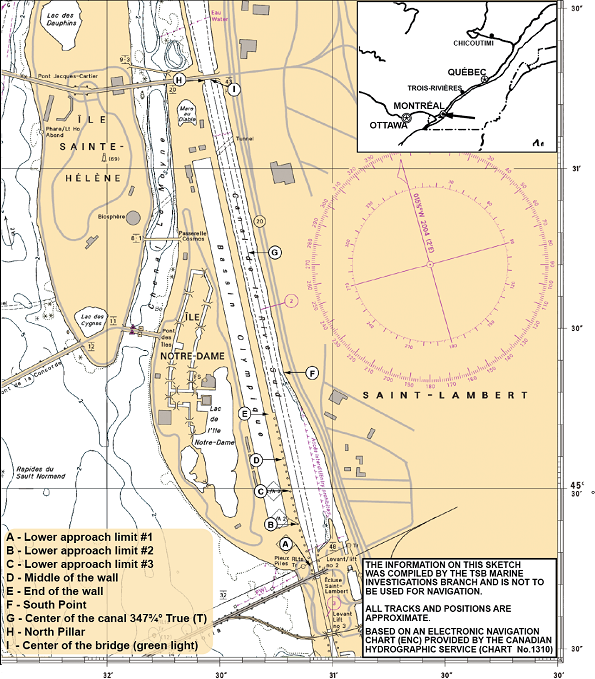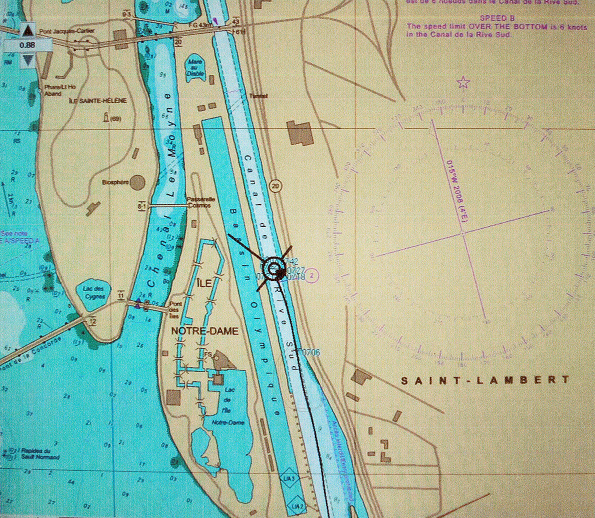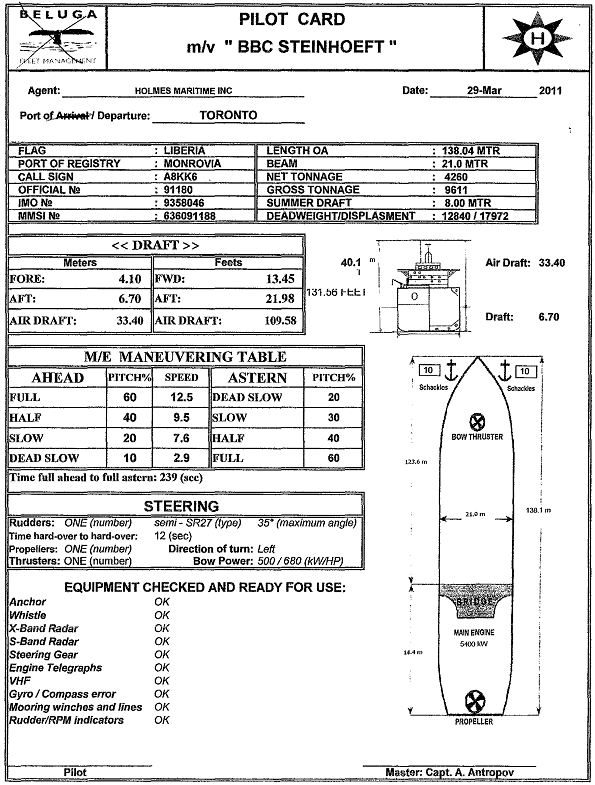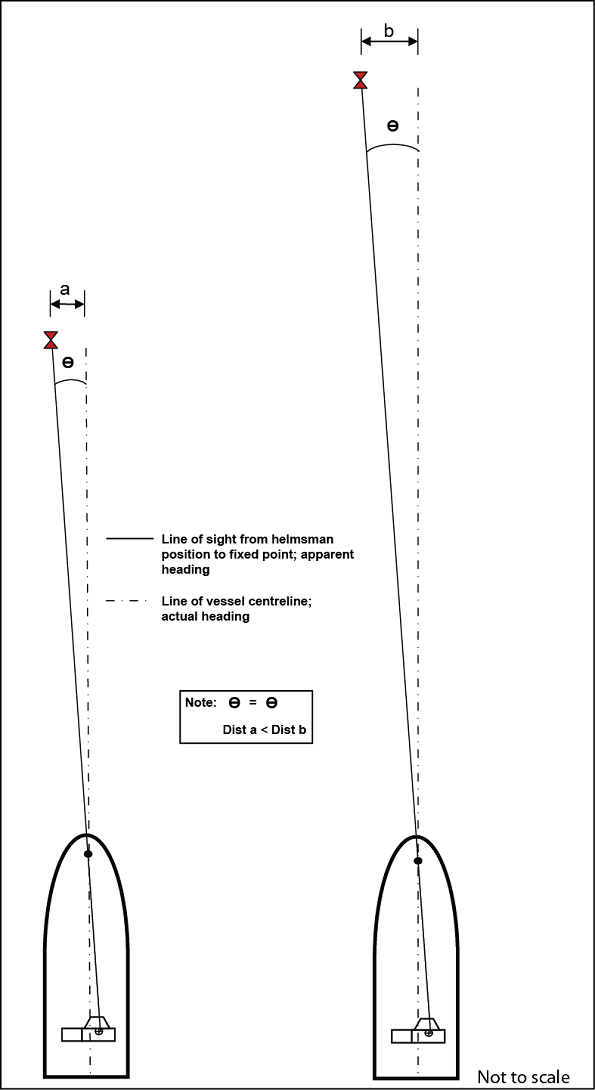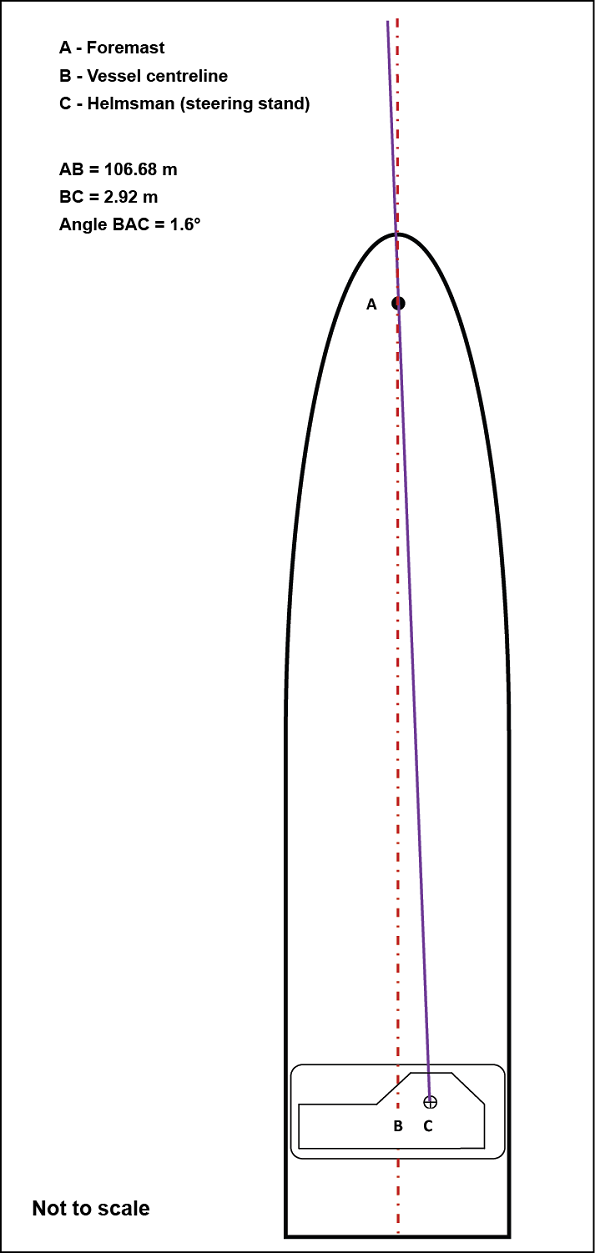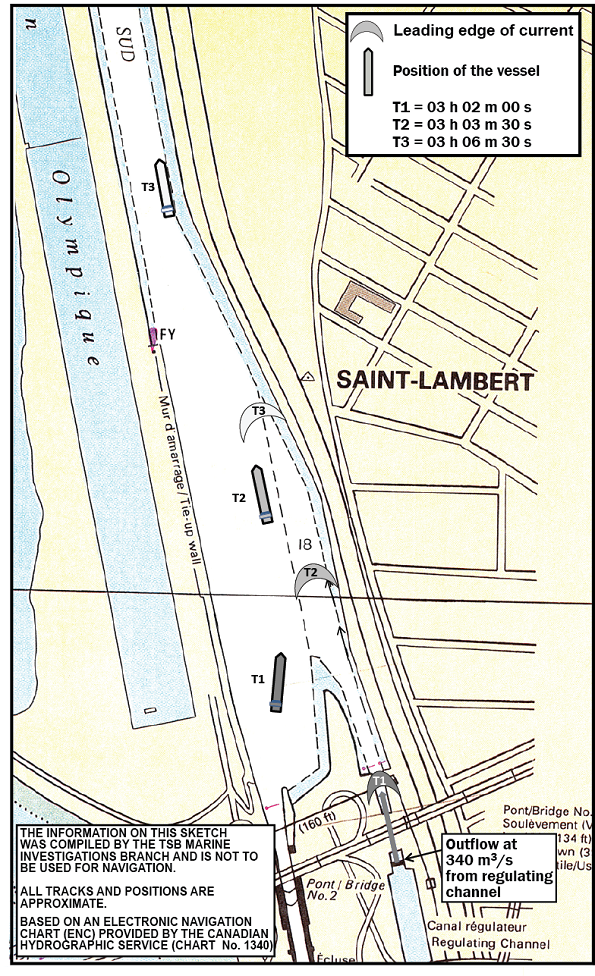Grounding
Multipurpose Cargo Ship BBC Steinhoeft
South Shore Canal of the
St. Lawrence Seaway,
Saint-Lambert, Quebec
The Transportation Safety Board of Canada (TSB) investigated this occurrence for the purpose of advancing transportation safety. It is not the function of the Board to assign fault or determine civil or criminal liability. This report is not created for use in the context of legal, disciplinary or other proceedings. See Ownership and use of content. Masculine pronouns and position titles may be used to signify all genders to comply with the Canadian Transportation Accident Investigation and Safety Board Act (S.C. 1989, c. 3).
Summary
On 31 March 2011 at 0309 Eastern Daylight Time, the downbound vessel BBC Steinhoeft, under the conduct of a pilot, ran aground in the South Shore Canal of the St. Lawrence Seaway downstream of St. Lambert Lock. Seaway traffic remained closed for 10 hours after the grounding until the vessel was refloated by 2 assisting tugs. There were no injuries or pollution as a result of this occurrence.
Factual information
Particulars of the vessel
| Name of vessel | BBC Steinhoeft |
|---|---|
| IMO number | 9358046 |
| Port of registry | Monrovia, Liberia |
| Flag | Liberia |
| Type | Multipurpose cargo ship |
| Gross tonnage | 9611 |
| LengthFootnote 1 | 138.17 m |
| Draft | Forward: 4.15 m Aft: 6.70 m |
| Built | 2006, Jiangzhou Union Shipbuilding Co Ltd., China |
| Propulsion | One MaK 6 cylinder diesel engine, 5400 kW, driving a controllable pitch propeller |
| Cargo | General crated cargo, 1101.4 tonnes |
| Crew | 15 |
| Registered owner | Baumwall GmbH & Co. KG, Germany |
| Manager | Reederei Elbe Shipping GmbH & Co. KG, Germany |
Description of the vessel
The BBC Steinhoeft is a multipurpose steel cargo vessel, strengthened for heavy cargo, with machinery and accommodations spaces located aft. The 3 cargo holds are serviced by two 120–tonne electrical hydraulic cranes mounted on the port side.
To improve visibility with the fitting of these 2 cranes, the conning position (the helmsman's steering stand) is offset to the starboard side of the centreline of the vessel (Figure 1).
The bridge is equipped with all the required navigational equipment including both 3 cm and 10 cm radars distributed symmetrically on the navigation console. An electronic chart display (ECD) is situated on the right hand side of the starboard pilot seat. The engine controls are situated close to the starboard pilot seat.
History of the voyage
On 29 March 2011 at 1950,Footnote 2 the BBC Steinhoeft departed Toronto, Ontario, for Philadelphia, Pennsylvania, United States, downbound through the St. Lawrence Seaway with 1100 tonnes of general crated cargo.
When the vessel arrived at St. Lambert Lock at 0240 on 31 March 2011, the 2 Great Lakes Pilotage Authority (GLPA) pilots on board were relieved by 2 Laurentian Pilotage Authority (LPA) pilots for the voyage from Saint-Lambert, Quebec, to Trois-Rivières, Quebec. The new LPA pilots were informed by the GLPA pilots that the gyro-compass was 3° high.Footnote 3
A master–pilot exchange was then carried out between the Master and Pilot No. 1. During this exchange, Pilot No. 1 was authorized to operate the pitch control and was informed about the propeller direction of rotation, the draft, the speed versus the pitch, the bow thruster power and the rudder specification. Meanwhile, Pilot No. 2 connected his portable pilot unit (PPU) to the automatic identification system (AIS) pilot plug and proceeded to set up the PPU for navigation.
At 0252, the mooring lines were let go and the vessel proceeded at pitch 10%Footnote 4 under the conduct of Pilot No. 1.
At 0300, the vessel cleared the lock walls at a speed over the ground (SOG) of approximately 4 knots. The pilot then asked the Master to increase the pitch to 20% and the helmsman to steer on a heading of 353° gyro (G) to bring the vessel to the southFootnote 5 of the channel centreline (Appendix A). This manoeuvre was standard practice to compensate for the flow (typically 225 m³/sec) coming from the regulating channel, starboard of the vessel. Soon after, the Officer of the Watch (OOW) returned to the bridge from tending the lines and he and the Master began a general discussion of vessel business at the communication workstation.
Adjacent to the lock is a weir co-located with a hydroelectric facility. This weir contains vanes that release and control the flow of water into the channel.
Just before 0302, as the vessel was passing lower approach limit number 2, approximately 385 m downstream of the weir, the St. Lambert Lock master opened the vanes of the weir to regulate the water level between the Saint Catherine and St. Lambert locks, thus increasing the flow from 225 to 340 m³/sec.
At 0303, Pilot No. 1 ordered the helmsman to steer on the light in the middle of the Jacques-Cartier bridge span to bring the vessel back towards the center of the channel. The Seaway Beauharnois Traffic Control Station informed the bridge team that the Jacques-Cartier bridge pillars were not illuminated.
The Master and the OOW ended their discussion at the communication workstation and moved to the fore part of the bridge to join Pilot No. 1. By this time, the vessel had reached the lower No. 3 approach limitFootnote 6 and was proceeding at an SOG of 5.5 knots.
At approximately 0304, Pilot No. 1 observed that the vessel's heading was deviating by 0.5° to either side of the light in the middle of the bridge span and gave the helmsman rudder orders to bring the vessel towards the north pillar of the Jacques-Cartier Bridge, which was not illuminated but was visible. Once the vessel was steadied on the pillar, Pilot No. 1 found the heading to be 349.5°G and ordered the helmsman to steer 349°G to make 346° true (T). Since the course of the channel was 348°T, this heading would bring the vessel towards the center more quickly. Pilot No. 1 then reduced the pitch to 15%.
At 0305, at the end of the lower approach wall, Pilot No. 1 observed that the vessel was more south than expected, but this was not judged to be abnormal. Pilot No. 1 then reduced the pitch to 10% for the entry into the narrower part of the channel.
At 0306, the vessel entered the restricted part of the South Shore Canal, making way along the south bank at an SOG of 6.8 knots with a heading of 350°G. At around this time, the helmsman had to apply starboard rudder to keep the vessel on the desired heading. At 0307:30, the vessel's course took a sudden sheer to port.
Immediately, Pilot No. 1 ordered the rudder hard to starboard and requested that the Master activate the bow thruster.Footnote 7 Then Pilot No. 1 used the controllable pitch propeller lever to produce an engine kick ahead.Footnote 8 Pilot No. 1 then set the controllable pitch propeller lever at full astern but the vessel continued crossing the channel at a 45° angle.
At 0309:40, the vessel grounded on the north bank of the South Shore Canal some 0.75 nautical miles from the St. Lambert Lock at latitude 45°30′ 35″ N, and longitude 073°31′ 19″ W. In its grounded position, the BBC Steinhoeft blocked the channel; vessel traffic was interrupted until 1320 the same day, when the vessel was successfully refloated.
Electronic voyage data
All information about time, course, speed and the vessel's position during the occurrence was obtained from Pilot No. 2's PPU and the AIS recording from the St. Lawrence Seaway Management Corporation (SLSMC). The vessel's track can be seen in an image taken from the vessel's electronic chart display (ECD) (Appendix B).
Voyage data recorder
In addition to bridge audio, a voyage data recorder (VDR) is capable of recording such items as time, vessel heading and speed, gyrocompass, alarms, very high frequency (VHF) radiotelephone communications, radar, the echo-sounder, wind speed and direction, and rudder/engine orders and responses.
When the TSB attempted to download the BBC Steinhoeft's VDR data following the occurrence, the VDR was found to have ceased functioning the day before the occurrence on 30 March 2011 at approximately 1600 Coordinated Universal Time (UTC). Consequently, no data from the time of the occurrence were available to the investigators when the remote storage module was analyzed at the TSB laboratory.
On 1 April 2011, a manufacturer representative checked the VDR and found that the data process unit (DPU) fan was operational but that the filter was clogged. Furthermore, the data management module (DMM) had shut down, its fan was not operational, and the battery was completely discharged.
The VDR manufacturer's installation and maintenance manual indicates that it is essential that proper airflow be maintained within the DPU through the fan system.Footnote 9 To ensure this, the fan filter needs to be cleaned every 3 months. Crew members were not able to provide a copy of this manual at the time of the attempted data retrieval.
Automatic identification system
An AIS is an automated tracking system used on vessels and by vessel traffic services (VTS) to identify and locate vessels by exchanging data (e.g., position, course and speed) electronically with other nearby vessels and VTS stations.
An AIS unit is configured by entering the vessel particulars. Given that the GPS antenna is used for navigation, its position is used as the reference point for AIS information. Four component offsets are entered to locate the GPS antenna with respect to the vessel's dimensions: i.e., (A) represents the distance from the GPS antenna to the bow, (B) the stern, (C) the port side and (D) the starboard side. The BBC Steinhoeft AIS was broadcasting the following values: (A) = 0, (B) = 138, (C) = 10 and (D) = 11, indicating a GPS antenna location that was at the bow of the vessel. However, the actual location of the GPS antenna was on top of the navigation bridge. Information gathered during the investigation indicates that a large number of vessels required to carry AIS have an antenna location that is not correctly configured.Footnote 10
Post-occurrence underwater survey
On 1 April 2011, an underwater survey of the BBC Steinhoeft was conducted that revealed the following:
- Shell plating scruff marks in way of the fore part of the hull
- 1 dented propeller blade
- Articulated flap rudder linkage with loose pins, also minor scratches on the underside of the rudder
- Bent bow thruster blades
The same day, main engine and steering gear were also tested and found to be functioning.
Vessel certification
The BBC Steinhoeft was crewed, certificated and equipped in accordance with existing regulations.
Bridge team certification and experience
The crew of the BBC Steinhoeft were all properly certified for their positions onboard. The Master had sailed as master on various vessels since 2004. He had been master of the BBC Steinhoeft since 5 January 2011. The OOW had been sailing as a deck officer since 2005. The helmsman had been sailing since 1998. He joined the vessel on 4 September 2010 and had spent minimal time acting in the position of helmsman.
Pilot No. 1 held a Master Near Coastal and Chief Mate (no restrictions) certificate of competency and was a Class B1, District 1,Footnote 11 licensed pilot, having acquired 3 years of piloting experience after completing his 2 years of apprenticeship. Pilot No. 2 held a Master Mariner certificate of competency and was a Class B2, District 1, licensed pilot.
Pilot card
The pilot card on board the BBC Steinhoeft was dated 29 March 2011 at departure from Toronto, Ontario. The card provided general information about the vessel and its particulars: draft, manoeuvring characteristics, bow thruster and the length of the anchor chains (Appendix C). The schematic also detailed the position of the navigating bridge, portrayed as being symmetrical to either side of the centreline of the vessel.
The card also presented a checklist of equipment that had been checked and was ready for use. Steering information was also provided, indicating “1 semi-SR 27 (type) 35° (maximum angle)” rudder, 1 left turning propeller, and 1 bow thruster.
None of the documentation on the bridge indicated that the conning position was offset from the centreline. Furthermore, this documentation did not clearly indicate that the vessel was equipped with an articulated flap–type of rudder,Footnote 12 nor were the Master or other crew members aware of this.
The International Maritime Organization (IMO) Resolution A.601 (15) is a recommendation on the provision and the display of manoeuvring information on board vessels. It recommends that the manoeuvring information be presented on a pilot card, a wheelhouse poster and in a manoeuvring booklet. Moreover, the pilot card should describe the current condition of the vessel with regard to its loading, propulsion and manoeuvring equipment, and other relevant equipment.
Lighting in the South Shore Canal
The South Shore Canal is fitted with lighting that outlines the banks of the canal. The lights on the south shore embankment from the entrance of the South Shore Canal in the port of Montreal, Quebec, to the St. Lambert Lock and those on the pillars of the Jacques-Cartier Bridge had been extinguished since the fall of 2010 due to underground wiring problems.
At the time of the occurrence, the SLSMC had plans to restore the canal lighting in January 2012.
Parallax
Parallax is a displacement or difference in the apparent position of an object viewed along 2 different lines of sight, and is measured by the angle between those 2 lines. In the context of vessel navigation, a parallax error may occur when a vessel is being steered on a line of sight towards a fixed point, when that line of sight is taken from a position that is not on the centreline of the vessel (Appendix D).
On the BBC Steinhoeft, the steering stand was 2.92 m to starboard of the centreline of the vessel. This resulted in a parallax error of approximately 1.6° to starboard if the line of sight is taken from the steering stand (Appendix E). Pilot No. 1 was aware that the steering stand was offset from the centreline, but had estimated the potential error to be about 0.5°.
Photos 2, 3, 4 and 5 were taken on board a sister vessel of the BBC Steinhoeft and illustrate this concept. Photo 2 shows a view taken from the steering stand position on the bridge.
Photo 3 shows a zoomed view taken from the steering stand position on the bridge. When viewing in line with the forward mast from this point, the left-hand arrow indicates the reference point ashore being viewed, whereas the right-hand arrow indicates the reference point ashore as it would be viewed if one stood on the centreline and took a line of sight with the forward mast. Photo 4 is of the same view, but taken when standing on the centreline of the bridge.
Photo 5 shows how, on the sister vessel to BBC Steinhoeft, the centreline of the vessel is marked on a plate in front of the bridge windows to aid the navigating officer in lining up the vessel.
Bank suction effect
As a vessel moves forward, displaced water produces a cushion effect at the bow before filling the void behind the stern; lateral pressures are thus balanced. When a vessel is close to one side of a channel, a yawing moment may be produced. The elevation of the water between the vessel and the near bank of the channel is less than the other side, and the resultant force tends to move the stern toward the near bank. This effect is known as bank suction. Its magnitude is influenced by several factors, including vessel distance from the bank, vessel speed, under keel clearance, and channel profile.Footnote 13
Water regulation at St. Lambert Lock
Water level
In order to maintain an adequate level of water in the Seaway system, operators regulate the quantity of water at the weir vanes and at the hydro power station located at the St. Lambert Lock. The SLSMC instructs operators to refrain from increasing the flow from 225 to 285 m³/sec while an upbound vessel is between calling-in point (CIP)Footnote 14 No. 2 and the St. Lambert Lock, or when a downbound vessel is between the CPR Bridge and St. Lambert Lock.Footnote 15 At the time, these instructions did not include any restrictions from opening the weir vanes once a downbound vessel had exited St. Lambert Lock, as when the BBC Steinhoeft exited on the day of the occurrence.
Ice flushing
Operators remove any floating pieces of ice that accumulate in the lock. To accomplish this, water is admitted into the lock through the upper filling valves while the lower side main doors are left open, thus creating a flow of water that carries the ice outside the lock.Footnote 16 During the transit of the BBC Steinhoeft, there was no ice flushing.
Analysis
Events leading to the grounding
When the BBC Steinhoeft exited the St. Lambert Lock, Pilot No. 1 gave a heading order to bring the vessel to the south of the centreline of the channel. This was a standard manoeuvre and it went as planned.
At the position where Pilot No. 1 intended to head the vessel back towards the center of the channel, before the mid-point of the lower approach wall, he ordered the helmsman to steer on a visual reference point at the center of the bridge, the green light, which was approximately 1.3 nautical miles ahead.
The helmsman's position at the wheel was offset to starboard of the centreline and he was using the forward mast as a reference to point the vessel. As a result, there was a parallax error of about 1.6° to starboard of the Pilot No. 1's intended track. For this reason, the vessel followed a path that brought it closer than desired to the south bank of the channel, despite a subsequent correction to line up the vessel with the north pillar.
The electronic voyage data indicate that as the vessel approached the narrower part of the channel, its track deviated momentarily towards the north, returning then to its original path. As there was no change in course at this time, this deviation was most likely the result of drift induced by the current.
At the same time, the current coming from the regulating channel was the usual current created by the flow of 225 m³/sec from the hydro power station. The leading edge of the increased current, caused by the opening of the weir vanes and the associated increase in water flow to 340 m³/sec, was still upstream, aft of the vessel's position.
The schematic in Appendix F shows the positions of the vessel and the corresponding position of the leading edge of the current, starting just after the time at which the outflow increased to 340 m³/sec (T1).Footnote 17 When the vessel experienced the bank effect (T3 in Appendix F), the flow had reached only a point past the mid-wall and could not have any effect on the vessel. Ice flushing operations were not being carried out at the time of the occurrence and thus had no influence on the current. As the vessel approached the entrance to the narrower part of the channel, it began to experience a bow cushion effect; the helmsman responded by applying starboard helm to keep the vessel on course. Once the vessel became parallel with the bank, it experienced the full bank suction effect and started its sheer to port. All attempts to counteract the sheerFootnote 18 were ineffective in the short time and limited space available, and the vessel ran aground, blocking the channel.
Information for the pilot
While Pilot No. 1 was aware of the possibility of a parallax error in navigation due to the offset position of the steering stand, he estimated that error to be about 0.5° and therefore did not compensate for this when giving his navigation orders to the helmsman. The investigation determined that this error was in fact 1.6°.
In navigational areas where tolerances are small, such as in this occurrence, accuracy is of the utmost importance. However, the determination of the parallax error induced by an offset bridge layout is not something that can be accomplished accurately without specific information. In this occurrence, Pilot No. 1 was not provided with such information, and therefore underestimated the extent of the parallax error.
Exchange of information with the pilot
According to International Maritime Organization (IMO) Resolution A.601 (15), a vessel's pilot card is intended to provide information to the pilot upon boarding. This information should describe the current condition of the vessel with regard to its loading, propulsion and manoeuvering equipment, and any other relevant equipment.
While the IMO guidelines specifically recommend that pilot cards provide information about the vessel's dimensions including the location of the bridge and air draft, they also recommend the provision of other information relevant to the vessel concerned. Pilot cards are intended for the use of pilots, but they may also be referred to by other bridge team members such as masters and officers of the watch.
The pilot card on board the BBC Steinhoeft did not provide any specific information about the offset steering stand position and the accompanying potential for parallax error (Appendix C), nor did the master–pilot exchange. As demonstrated by this occurrence, the absence of this type of specific information could contribute to navigational errors, placing the vessel and its crew at risk.
The Pilot Card also did not contain information that the vessel was equipped with an articulated flap type of rudder. The rudder arrangement type is one of the essential vessel particulars that need to be known to safely conduct a vessel.
Physical markers
There are various means by which vessels with an offset bridge configuration can indicate the appropriate line of sight to prevent parallax errors. These means include physically marking the centreline of the vessel on the bridge, and/or installing a marker at the bow of the vessel that would be positioned with the same offset as the steering stand on the bridge and would assist the helmsman to steer on a parallel line of sight with the centreline. On the BBC Steinhoeft, there were no such physical indications. In the absence of such measures, the risk of navigational errors due to parallax increases.
Lighting in the South Shore Canal
At night, Seaway infrastructure lighting points along the embankment and on the Jacques-Cartier bridge pillars may be used as visual cues by navigators. These visual cues may be especially useful when exiting the open waterway off the lower approach wall and entering into the confined waterway of the South Shore Canal.
On the night of the occurrence the lighting points on the south embankment and on the Jacques Cartier bridge pillars were not available because the underground wiring had not been repaired. Although it was not a contributing factor to this occurrence, the lack of such visual cues may increase the difficulty for navigators in assessing their position relative to the bank.
Voyage data recorder
The purpose of a voyage data recorder (VDR) is to create and maintain a secure, retrievable record of information indicating the position, movement, physical status, and control of a vessel for the period covering the most recent 12 hours of operation. Objective data are invaluable to investigators when seeking to understand the sequence of events and identify operational problems and human factors.
In this occurrence, the VDR on the BBC Steinhoeft was found to have ceased functioning prior to the grounding. When VDR data, in particular the bridge audio recordings, are not available to an investigation, identification and communication of safety deficiencies to advance transportation safety may be precluded.
Findings
Findings as to causes and contributing factors
- The steering stand of the BBC Steinhoeft was offset from the centreline, and specific and detailed information was not provided to Pilot No. 1 to allow the accurate determination of parallax error.
- After Pilot No. 1 ordered the helmsman to steer on a visual reference point, the vessel followed a path that brought it closer than desired to the south bank of the channel.
- As the vessel approached the entrance to the narrower section of the channel, it experienced a bank suction effect that caused a sheer to port.
- All attempts to counteract the sheer were ineffective in the short time and limited space available, and the vessel ran aground, blocking the channel.
Findings as to risk
- The absence of specific information regarding the offset steering stand position and potential parallax error, such as on the pilot card or by physical marking, may contribute to navigational errors, placing the vessel and its crew at risk.
- The lack of Seaway infrastructure lighting may increase the difficulty for navigators in assessing their position relative to the bank.
- When voyage data recorder (VDR) data, in particular the bridge audio recordings, are not available to an investigation, identification and communication of safety deficiencies to advance transportation safety may be precluded.
Other findings
- On-board documentation did not clearly identify the vessel's rudder type, nor were the bridge team members aware that the vessel was fitted with an articulated flap rudder.
- A large number of vessels required to carry an automatic identification system (AIS) have a GPS antenna location that is not correctly configured.
Safety action
Action taken
TSB
On 21 July 2011, the TSB issued a Marine Safety Information Letter 06/11 to the ship manager, Elbe Shipping Reederei, GmbH & Co. KG, suggesting it review the onboard inspections and measures with regards to the voyage data recorder (VDR) and the configuration of the GPS antenna in the automatic identification system (AIS), as well as to ensure that the vessel documentation such as the pilot card and general arrangement plan posted in the wheelhouse indicate and show the actual rudder arrangement of the vessel. No response has been received.
On 25 November 2011, the TSB issued a Marine Safety Advisory Letter 05/11 to the ship manager, Elbe Shipping Reederei, GmbH & Co. KG, to consider initiating measures on the BBC Steinhoeft and other vessels within its fleet with similar offset steering stand bridge configurations to ensure that information is provided on board to assist navigating personnel to accurately account for potential parallax errors. On 25 November 2011, the TSB issued a Marine Safety Advisory Letter 06/11 to the Laurentian Pilotage Authority (LPA) to raise the awareness of pilots as to the potential for parallax error on vessels with off-centre bridges, and the necessity of obtaining detailed information during master–pilot exchanges regarding the possible extent of such error from the conning position.
On 14 May 2012 the TSB issued Marine Safety Advisory Letter 01/12 to the St. Lawrence Seaway Management Corporation (SLSMC) regarding the means to compensate for parallax error induced by offset steering positions. The letter advised the SLSMC that it may wish to put in place measures to ensure that vessels entering the Seaway that have offset steering stations are equipped with markings to identify a suitable line of sight to aid in visual navigation.
SLSMC
In mid-summer 2011, the SLSMC repaired the lighting below the St. Lambert Lock; the south-side embankment and the Jacques Cartier pillar lighting points are now operational.
The SLSMC has also modified the instructions to its operators. The increase of flow from 225 to 285 m³/sec has been restricted for downbound vessels until they reach the CIP No. 2 instead of out of St. Lambert Lock.Footnote 19
The SLSMC also plans to install a green light at the beginning of the narrow part on the south bank of the south shore canal below the St. Lambert Lock.
LPA
On 23 December 2011, the LPA forwarded TSB's Marine Safety Advisory Letter 06/11 to the Corporation des pilotes du Saint-Laurent central.
This report concludes the Transportation Safety Board's investigation into this occurrence. Consequently, the Board authorized the release of this report on . It was officially released on .
